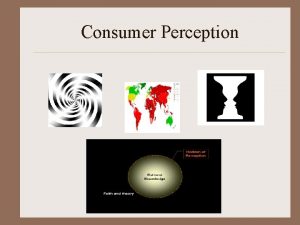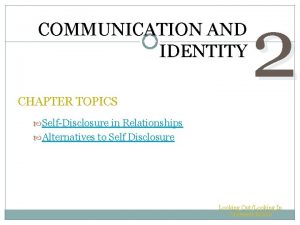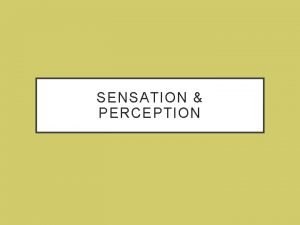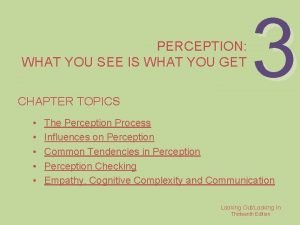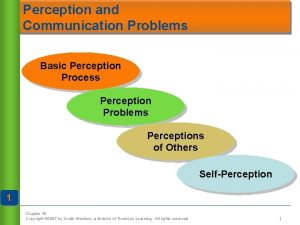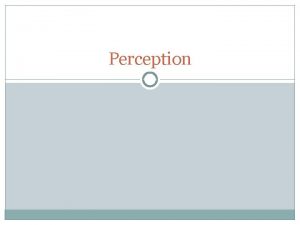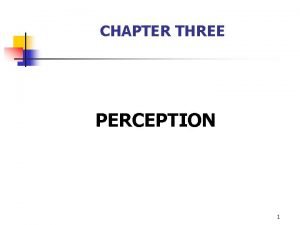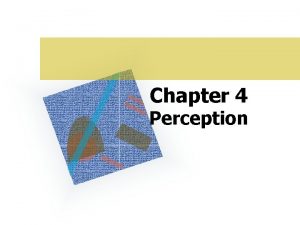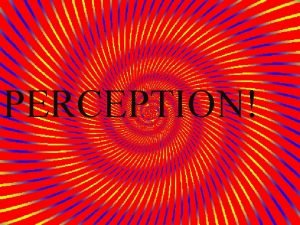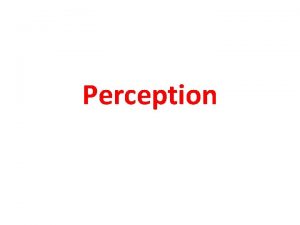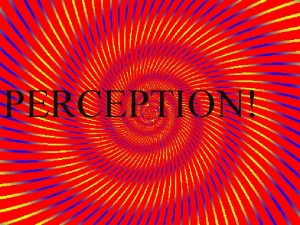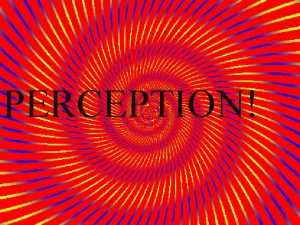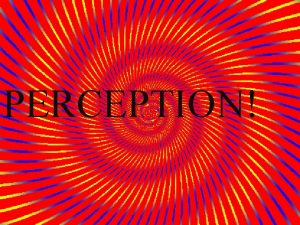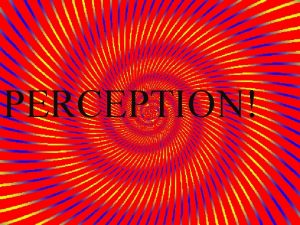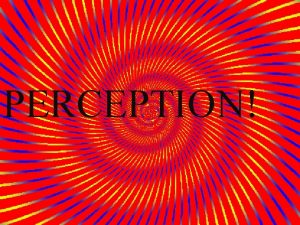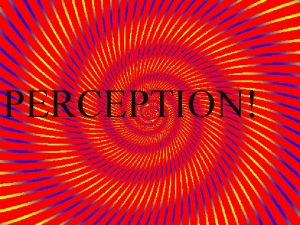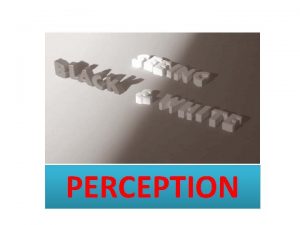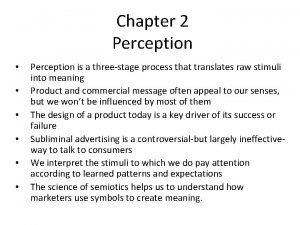Chapter FOUR Perception Perception is the process of





















- Slides: 21

Chapter FOUR Perception

Perception is the process of acquiring, selecting, organising and interpreting sensory information in order to give meaning to their environment

Perception Environmental Stimuli Feeling Hearing Seeing Smelling Selective Attention Perceptual Organisation and Interpretation Emotions and Behaviour Tasting

Inputs or Environmental Stimuli Throughput/ Perceptual Mechanism Perceptual Interpretation PERCEPTUAL ERROR Perceptual Selection EXTERNAL FACTOR Events People SENSES Objects Physical Environment Size Location Intensity Familiarity Contrast Motion Repetition Novelty & Familiarity INTERNAL FACTORS OBSERVATION Socio cultural Environment Output/ Response Past Experiences Age Interest Needs Expectations Beliefs Ambivalence Paranoid perception Current Psychological or Emotional state Personality Factors Perceptual Defense Perceptual set Stereotyping Projection Self-fulfilling Prophecy Halo Effect Selective Perception Recency Effect ATTRIBUTION Internal Vs External Causes For success and failure Perceptual Organisation Ambiguous figures Figure ground Perceptual grouping *Proximity *Continuity *Similarity *Closure *Constancy shape, size & color Covert & Overt Attitude Motivation Feelings Opinions Values Behaviour

Situational Factors affecting Perceptual Mechanism Ø Ø Physical Settings Social Settings Organisational Settings Timing

Figure Ground

Closure

Proximity

Similarity

Smooth connectedness

Perceptual Defense Refers to the tendency among people to protect themselves against ideas, objective or situations which seem threatening 1. 2. 3. 4. Denial Modification Refusal to change mechanism Change in perception

Attribution is the complex process in which we observe others behaviour and try to infer causes behind it form various areas. OBSERVATION INTERPRETATION ATTRIBUTION OF CAUSE

Attribution Internal Attribution Frequently (High) Frequently (Low) Seldom (Low) Consistency Distinctiveness Consensus How often did the person act this Way in the past? How often does the Person Act this way in other settings? How often do this way in similar situations? Seldom (low) Seldom (high) External Attribution Frequently (high)

Errors and Biases in Attributions Ø Fundamental Attribution Error – The tendency to underestimate the influence of external factors and overestimate the influence of internal factors when making judgments about the behavior of others – We blame people first, not the situation Ø Self-Serving Bias – The tendency for individuals to attribute their own successes to internal factors while putting the blame for failures on external factors – It is “our” success but “their” failure 6 -14

Self fulfilling Prophecy (Pygmalion effect) When expectations about others cause them to act in a way that is consistent with those expectations. Expectation formed Expected Behaviour performance Behaviour towards that person Effect on the person

Specific Shortcut Applications in Organizations Ø Employment Interview – Perceptual biases of raters affect the accuracy of interviewers’ judgments of applicants – Formed at a single glance: 1/10 th of a second! Ø Performance Expectations – Self-fulfilling prophecy (Pygmalion effect): The lower or higher performance of employees reflects preconceived leader expectations about employee capabilities Ø Performance Evaluations – Appraisals are often the subjective (judgmental) perceptions of appraisers of another employee’s job performance – Critical impact on employees 6 -16

Perceptions and Individual Decision Making Ø Problem – A perceived discrepancy between the current state of affairs and a desired state Ø Decisions – Choices made from among alternatives developed from data Ø Perception Linkage: – All elements of problem identification and the decision-making process are influenced by perception. • Problems must be recognized. • Data must be selected and evaluated. 6 -17

Overcoming Perceptual Distortion 1. Knowing and perceiving oneself accurately FEEDBACK Known to self DUSCLOSURE Known to others OPEN AREA HIDDEN OR PRIVATE AREA Unknown to others Unknown to self BLIND AREA UNKNOWN AREA OR DARKK SIDE JOHARI WINDOW

Overcoming Perceptual Distortion 2. Being Emphatic 3. Having positive attitude 4. Enhancing self concept or self image at workplace 5. Authentic and open communication 6. Avoiding attribution 7. Trust and trusting others 8. Avoiding perceptual errors

Developing Perceptual skills to reduce perceptual Errors 1. Keep in mind the way perceptual process works 2. Compare one’s perception with the perception of other people 3. Effective communication 4. Understanding other persons point of view 5. Willingness to change one’s attitude and behaviour ones come across new information 6. View the world in dynamic terms 7. See things with positive attitude and avoid personal biases or negative feelings about others to avoid distortion of perception.

Application of perception in OB 1. 2. 3. 4. Employment interview Performance appraisal and expectation Assessing level of efforts Assessing loyalty
 What affects perception
What affects perception Perception checking process
Perception checking process Process of perception
Process of perception Consumer perception process
Consumer perception process Pillow method communication
Pillow method communication Define monocular cues
Define monocular cues Perception checking scenarios
Perception checking scenarios The perception process
The perception process Hình ảnh bộ gõ cơ thể búng tay
Hình ảnh bộ gõ cơ thể búng tay Lp html
Lp html Bổ thể
Bổ thể Tỉ lệ cơ thể trẻ em
Tỉ lệ cơ thể trẻ em Gấu đi như thế nào
Gấu đi như thế nào Tư thế worm breton là gì
Tư thế worm breton là gì Bài hát chúa yêu trần thế alleluia
Bài hát chúa yêu trần thế alleluia Các môn thể thao bắt đầu bằng tiếng chạy
Các môn thể thao bắt đầu bằng tiếng chạy Thế nào là hệ số cao nhất
Thế nào là hệ số cao nhất Các châu lục và đại dương trên thế giới
Các châu lục và đại dương trên thế giới Công thức tính độ biến thiên đông lượng
Công thức tính độ biến thiên đông lượng Trời xanh đây là của chúng ta thể thơ
Trời xanh đây là của chúng ta thể thơ Cách giải mật thư tọa độ
Cách giải mật thư tọa độ 101012 bằng
101012 bằng



